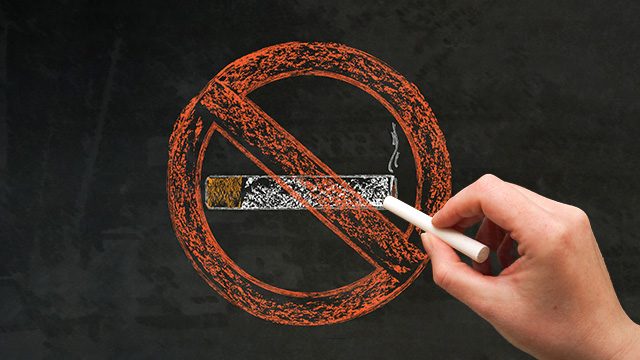SUMMARY
This is AI generated summarization, which may have errors. For context, always refer to the full article.

MANILA, Philippines – Tobacco-control advocates on Friday, May 19, hailed Executive Order 26, which provides for the establishment of smoke-free environments in public and enclosed spaces, as a “positive step” to making the Philippines smoke-free.
“The success of it being implemented still depends on our law enforcers and the local government units,” HealthJustice president Mary Ann Mendoza said in a statement.
HealthJustice is a public health policy think tank and advocacy group, with expertise in tobacco control and health promotion.
Ulysses Dorotheo of the Southeast Asia Tobacco Control Alliance (SEATCA) agreed that the EO is a “step forward”, but noted that it is “not as strong as the Davao ordinance.“
The health department on Friday admitted that the EO was patterned after the Davao City ordinance “when it was in the early years of implementation.”
“There is no safe level of exposure to tobacco smoke,” Dorotheo, SEATCA’s Framework Convention on Tobacco Control program director, explained.
He added: “Only 100% smoke-free environments can adequately protect public health. This is the gold standard against which smoke-free policies should be compared.”
Mendoza also noted that there is no safe level of exposure to secondhand smoke (SHS), saying that even “brief exposure” to it can cause “serious damage” since SHS “causes heart disease, cancer, and many other diseases.”
“Only a total ban on smoking in all indoor public places, including workplaces, protects people from the harms of SHS exposure, helps smokers quit and reduces smoking,” she added.
Designated smoking areas
Since indoor designated smoking areas (DSAs) are “not ideal,” Mendoza urged building administrators to establish outdoor DSAs, or keep their establishments 100% smoke-free.
The EO lists the following as areas where smoking is not allowed, hence no DSA shall be provided:
- Centers of youth activity such as playschools, preparatory schools, elementary schools, high schools, colleges and universities, youth hostels, and recreational facilities for minors
- Elevators and stairwells
- Locations where fire hazards are present
- Within premises of public and private hospitals, as well as medical, dental, and optical clinics
- Food preparation areas
It also specifies that a “non-smoking buffer zone” be established for DSAs not located in open spaces.
New Vois Association of the Philippines president Emer Rojas said they consider the EO as an “enhancement” of Republic Act (RA) 9211 or the Tobacco Regulation Act of 2003 because it imposes “stricter measures” for designated smoking areas.
But Mendoza urged Congress to amend RA 9211 to remove indoor DSAs “so that we truly realize the constitutionally mandated right to health for Filipinos.”
President Rodrigo Duterte signed EO 26 on Tuesday, May 16, 7 months after the draft prepared by the Department of Health was first announced in October 2016. – Rappler.com
Add a comment
How does this make you feel?
There are no comments yet. Add your comment to start the conversation.